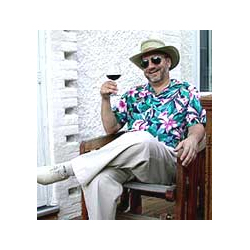
One thing I can say is that in my 25 years here, never once have I been asked by management to do anything that violated my personal ethics. And that’s real important.
Good times or bad times, you’re treated very well here. Plus I get paid to do my hobby, which is not too bad either!
KC: Can you tell me about some of your favorite co-workers through the years?
Michael: Well, that’s kind of a tricky question. If you start naming people, you invariably leave someone out. But I will talk about some of the important folks who have retired.
You have to start with Mr. (S.N.) Shure, who I was fortunate enough to know and work with. He was a very, very modest man, never taking credit for a whole lot of our success. People would come up to him at trade shows, shake his hand and tell him that he makes a great microphone, and he’d deflect it, saying ‘it’s not me, it’s the people that work with me’.
He was also a very approachable guy. For example, he had an interest in the history of words like I do, and we’d exchange notes about it. There was a personal aspect to him that went throughout the company, and there was also a kind of casualness about him – he was the driving force of a large corporation known around the world, but one that is run with a ‘mom and pop’ touch.
A gentlemen I did not know, Ben Bauer, was really the first brilliant engineer at Shure, creating the first Unidyne microphone – the single element, unidirectional microphone. This was in the late ‘30s, and is still probably the single greatest microphone achievement this company has given to the world.
We’re still building the Unidyne in one form or another. I didn’t know Mr. Bauer, but I know a bit about him by reading his papers that are still available here. A brilliant guy.
Another engineer who was here for a long time, since retired and unfortunately passed away, was Ernie Seeler. He developed the Unidyne III cartridge, which is better known as the SM58 and SM57. Ernie was ‘Mr. Precision’ – he had a German background but was born in Cuba – I don’t know how that happened – but his desk was perfectly aligned, everything in his office just so.
Interestingly, he created probably the most popular microphone for rock n’ roll, but he hated rock ‘n’ roll. He was a classical music fan.
Seated right next to him, like yin and yang, was Roger Anderson, another brilliant engineer, and one who was completely messy and the ‘gyro, gear-loose’ type. Roger created many of the advances we had in phono cartridges – Shure was the biggest maker of these in the ‘60s and ‘70s, and in fact, we still are to this day.
I was just in awe of these guys, working side-by-side with them, and they were amazing. Ernie would work things out with painstaking calculations and a lot of thought, and Roger was the great experimenter. They’re both very unique people that I’ll never forget.
KC: In your time, what are some of the most significant products and or technologies that have come out of Shure?
